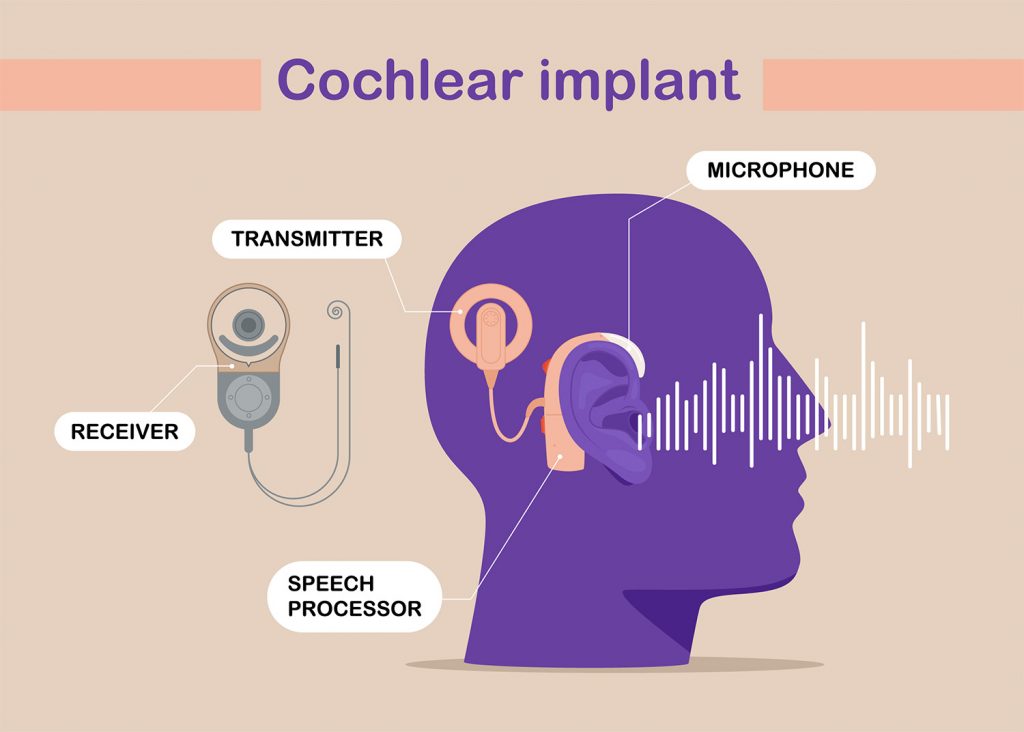A cochlear implant is a device that can help provide a sense of sound to someone who is deaf or hard-of-hearing. It consists of two main parts: an external part worn outside the ear, and an internal part surgically implanted inside the ear.
The external part includes a microphone that picks up sounds from the environment, a speech processor that analyzes the sounds and converts them into electrical signals, and a transmitter that sends the electrical signals to the internal part.
The internal part of the cochlear implant includes an receiver that receives the electrical signals from the transmitter and converts them into electrical stimulation patterns. This electrical stimulation is then sent to electrodes that are surgically implanted in the cochlea, the spiral-shaped organ of the inner ear that is responsible for converting sound into electrical signals that the brain can understand.
The electrical stimulation from the cochlear implant stimulates the auditory nerve fibers in the cochlea, which then send the signals to the brain where they are interpreted as sound. The result is a sensation of sound that can help people who are deaf or hard-of-hearing to understand speech and other sounds in their environment.
Cochlear implants can be used by people of all ages, including children as young as 12 months old, and have been found to be most effective when implanted at a young age. In order for a cochlear implant to be effective, the person must have some residual hearing in the ear being implanted, as well as an intact auditory nerve.
The success of cochlear implants varies from person to person, but many people report a significant improvement in their ability to hear and understand speech after receiving a cochlear implant. This can have a positive impact on their quality of life, allowing them to participate more fully in communication and social activities, as well as improve their ability to hear warning signals and other important sounds in their environment.
There are several different types of cochlear implants available, each with its own unique features and benefits. Some cochlear implants use a single electrode to deliver stimulation, while others use multiple electrodes to provide more precise stimulation. Some cochlear implants also have additional features, such as directional microphones and noise reduction algorithms, that can help improve hearing in noisy environments.
The use of cochlear implants is generally considered safe, but like any medical procedure, it does carry some risks. Some of the potential complications associated with cochlear implants include infection, bleeding, and hearing loss in the implanted ear. However, these complications are rare and can usually be successfully treated with antibiotics or other medical intervention.
Cochlear implants are a powerful tool for helping people who are deaf or hard-of-hearing to hear and understand speech and other sounds in their environment. With the help of a cochlear implant, many people are able to lead more fulfilling and active lives, participating more fully in communication and social activities. While there are risks associated with the use of cochlear implants, the benefits often outweigh the risks for many people, making cochlear implants an important option for those seeking to improve their hearing.
How Can Cochlear Implants Help With Sensorineural Hearing Loss?

Cochlear implants are devices that can help restore hearing in individuals with sensorineural hearing loss. Sensorineural hearing loss is a type of hearing loss that occurs when there is damage to the inner ear or the auditory nerve, which is responsible for transmitting sound signals from the ear to the brain.
Cochlear implants work by bypassing the damaged hair cells in the inner ear and directly stimulating the auditory nerve. The device consists of two main parts: an external component that sits outside the ear and an internal component that is surgically implanted under the skin.
The external component includes a microphone that captures sound from the environment, a speech processor that analyzes the sound, and a transmitter that sends electrical signals to the internal component. The internal component, or the implanted portion, includes a receiver and electrodes that are surgically placed in the cochlea, the spiral-shaped organ in the inner ear that converts sound into electrical signals.
The electrical signals from the transmitter are received by the receiver and then sent to the electrodes in the cochlea. The electrodes stimulate the auditory nerve fibers in the cochlea, sending sound information to the brain where it is interpreted as sound. This allows the individual with sensorineural hearing loss to hear and understand speech and other sounds.
Cochlear implants have been shown to be effective in restoring hearing in individuals with severe to profound sensorineural hearing loss. The success of cochlear implants depends on several factors, including the degree and type of hearing loss, the age of the individual at the time of implantation, and the length of time the individual has been deaf.
For individuals who have had hearing loss for an extended period of time, it can take time to adjust to the new sound perception provided by the cochlear implant. This adjustment period typically involves a rehabilitation process, including auditory training and speech therapy, to help the individual learn to interpret the new sounds they are hearing.
Cochlear implants can have a significant impact on the quality of life for individuals with sensorineural hearing loss. They can improve the ability to hear and understand speech, participate in communication and social activities, and hear important warning signals and other sounds in the environment.
The use of cochlear implants is generally considered safe, although like any medical procedure, it does carry some risks. Some of the potential complications associated with cochlear implants include infection, bleeding, and hearing loss in the implanted ear. However, these complications are rare and can usually be treated with antibiotics or other medical intervention.
Cochlear implants are a powerful tool for restoring hearing in individuals with sensorineural hearing loss. By bypassing the damaged hair cells in the inner ear and directly stimulating the auditory nerve, cochlear implants can provide a sense of sound that can greatly improve the quality of life for individuals with hearing loss. With the help of a cochlear implant, many individuals are able to lead more fulfilling and active lives, participating more fully in communication and social activities.
How Can You Find The Cochlear Implants That Best Suit Your Condition?

Finding the right cochlear implant can be a challenging but important process for individuals with sensorineural hearing loss. Cochlear implants are highly personalized devices, and the type and features of the device that are best suited for an individual will depend on several factors.
First, it is important to determine the degree and type of hearing loss that an individual has. This can be done through a comprehensive hearing evaluation by an audiologist. The audiologist will perform a series of tests to determine the extent of the hearing loss, including pure tone audiometry, speech audiometry, and impedance testing.
Once the degree and type of hearing loss have been determined, the next step is to consider the individual’s lifestyle and communication needs. This includes factors such as the type of work the individual does, their recreational activities, and their social and family situation. These considerations will help to determine the most appropriate type of cochlear implant, as well as the specific features that will best meet the individual’s needs.
It is also important to consider the individual’s age, as the type of cochlear implant and the features included will vary depending on whether the individual is a child or an adult. For example, children typically require a different type of cochlear implant with specific features designed to support their growth and development.
Another factor to consider is the individual’s ability to use the cochlear implant. This includes factors such as manual dexterity and visual acuity, as well as the individual’s ability to learn and use new technology.
Once the individual’s needs and abilities have been considered, the next step is to choose a cochlear implant provider. This can be done by researching different providers, reading reviews from other individuals who have received cochlear implants, and speaking with the individual’s audiologist.
When choosing a cochlear implant provider, it is important to consider factors such as the provider’s reputation, the quality of the devices they offer, and the level of support and training they provide to individuals with hearing loss.
Once the individual has chosen a cochlear implant provider, the next step is to schedule a consultation with a specialist. During this consultation, the specialist will perform a detailed evaluation of the individual’s hearing, including a review of their medical history, and will discuss the type of cochlear implant that is best suited for their needs.
It is also important to discuss the cost of the cochlear implant with the specialist, as well as the availability of financial assistance and insurance coverage. In some cases, the cost of a cochlear implant may be covered by insurance, while in others, the individual may need to pay for the device out-of-pocket or through a financing program.
Finding the right cochlear implant for an individual with sensorineural hearing loss requires careful consideration of several factors. By working closely with a specialist and taking into account the individual’s hearing loss, lifestyle, and communication needs, it is possible to find the cochlear implant that will best meet their needs and help them to hear and communicate more effectively. With the right cochlear implant, individuals with hearing loss can lead more fulfilling and active lives, participating more fully in communication and social activities.




